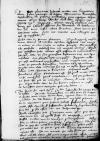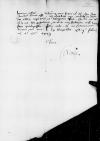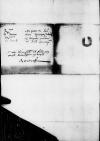Post plurimos labores tandem veni ⌊Bruxellam⌋, nam cum principio ad ⌊regem Rhomanorum⌋ divertissem exposuissemque illi, quaecumque occurrebant circa negotium orig. negocium⌈negotiumnegotium orig. negocium⌉ ⌊Helvetiorum⌋[2] et res ⌊Italiae⌋, deinde illud idem copiosius ipsi ⌊caesareae maiestati⌋ ⌊Moguntiae⌋.[3] Placuit utrisque consilium meum bonaque gratia caesaris assecutus sum commeatum ad hebdomadas sex, tunc iussus redire ad aulam, forte iterum pro Helvetici written over o⌈oii written over o⌉s rebus, quas aut movere, aut infringere hoc tempore est impossibile.
Audio vero te parare abitionem, id quod nequaquam orig. naequaquam⌈nequaquamnequaquam orig. naequaquam⌉ consulo, nam etiam si ad mensem Aprilem exspectes, ita venies in aulam, ut olim ⌊Cicero⌋ in castra ⌊Pompeii⌋, hoc certissime tibi persuade, habebisque tunc me comitem itineris. Deinde pro certissimo habe itinera esse pessima et incommodissima hoc tempore adeo, ut sine gravissimo discrimine vitae aut equo insidere, aut plaustro vehi non possis. Experto crede, qui ipse crediturus non fuissem, nisi magno meo cum metu et periculo didicissem. Tantum ubique est nivium et gelu, non adeo induratae sunt viae, ut equum ferre possint. Solum inter ⌊Coloniam⌋ et ⌊Bruxellas⌋ aliquoties cecidi, familiaris etiam periclitatus est, id quod in toto itinere mihi numquam orig. nunquam⌈numquamnumquam orig. nunquam⌉ fere prius intervenit. Sed pro prudentia tua facile scis, quid tibi incumbat. Tantum id mihi nuntia orig. nuncia⌈nuntianuntia orig. nuncia⌉, qui aliquot diebus adhuc ⌊hic⌋ sum futurus resciturus, an possim ex his praefectis aerario extorquere, quod mihi debent.
In itinere fui apud reverendissimum ⌊cardinalem Leodiensem⌋ die integro, nam id volebat. ⌊Is⌋ mihi iniunxit serio, non verbis utens, sed integre et sincere orig. syncere⌈sinceresincere orig. syncere⌉, prout virum bonum decet, rogavit etiam et omnino mandavit, ut tibi dicerem, si pecuniam non haberes p honori tuo et reputationi, quam hactenus habuisti, sufficientem, significares, sese eam tibi d suffecturum habiturumque singularis beneficii loco, quod suo officio non eris dedignatus uti. Deinde transeas per ⌊Curingam⌋, arcem ⌊ipsius⌋, quae est in recto itinere tuo ab oppido ⌊Diest⌋ ad ⌊Mastricht⌋ prope ⌊Hassel⌋, et illic cum eo transigas Quadragesimam.[4] Sese scire in aliena patria constitutis aliquando non omnia adesse. Praeter ea, quae tibi necessaria sunt, suffecturum, quibus possis pro meritis tuis et pro ea, quae tibi convenit reputatione, munitus esse. Ista non iniunxit, quo modo solent, qui nolunt officium nisi verbo testari, sed animo integro et tibi affecto, magno cum praeconio orig. preconio⌈praeconiopraeconio orig. preconio⌉ virtutum tuarum et ministrante illi ⌊⌋ illo,
 AAWO, AB, D. 3, f. 67v
quem tu promovisti ad ipsius servitium, filio, ni fallor, ⌊castellani Byecensis⌋, quem tui causa facit maximum, et id mihi dixit illo praesente. Nam quod ad ⌊iuvenem⌋ attinet, non video, cur illum debeat praeferre ⌊palatinis Rheni⌋,[5] ⌊ducibus Bavariae⌋[6] et comiti Reyngrave,[7] quorum liberos[8] apud se habet, praeter alios nostratis nobilitatis comites, quos vestris cedere non puto et bene scio.
AAWO, AB, D. 3, f. 67v
quem tu promovisti ad ipsius servitium, filio, ni fallor, ⌊castellani Byecensis⌋, quem tui causa facit maximum, et id mihi dixit illo praesente. Nam quod ad ⌊iuvenem⌋ attinet, non video, cur illum debeat praeferre ⌊palatinis Rheni⌋,[5] ⌊ducibus Bavariae⌋[6] et comiti Reyngrave,[7] quorum liberos[8] apud se habet, praeter alios nostratis nobilitatis comites, quos vestris cedere non puto et bene scio.
Cum ⌊illo⌋ solus pransus sum et cenatus, neque alium admittebat ministrum (nam vetitis vescebatur), nisi ⌊illum⌋, sive quod iuvenem illum vult bene instituere, sive quod multum tribuit fidei Polonicae, quorum utrumque facit tui causa non illius, quem non nisi nomine tuo et commendatione novit.
Non sum, qui possum tibi consulere, tamen rogo, habe rationem valetudinis tuae, nam ex affectu haec ad te scribo.
Scio, quod de conventu ⌊Pataviensi⌋[9] plura tibi persuadeas, sed nihil est. Nam qui ibi fuere ordinati, ⌊episcopus Labacensis⌋, ⌊Dieterichstein⌋, ⌊Herbestein⌋, doctor ⌊Beatus⌋, ⌊Alexius Thurso⌋, nondum abiere, sicut neque ⌊Fridericus palatinus Rheni⌋ et ⌊episcopus Spirensis⌋, qui ibidem sunt ex parte ⌊caesaris⌋ futuri. De parte vestra rumor est futurum ⌊Christophorum de Schydloviecz⌋ et alios. ⌊Hieronymus Lasky⌋ novissima legatione tam male se gessit, ut sit ⌊regi Rhomanorum⌋ et omnibus, qui eum ante suspiciebant, redditus exosus. ⌊Is⌋ praeterquam, quod venit ⌊Augustam Vindelicorum⌋ tractavitque cum L written over ...⌈... illegible⌈...... illegible⌉LL written over ...⌉utheranis oratoribus principum et civitatum omnium, quod ex commeatu facere prohibebatur, et cum hostibus imperii declaratis, scilicet clientibus ⌊Ioannis Thomae de Asberg⌋, quem aliquando tibi dixi occisum a ⌊Iudaeis⌋ in ⌊Bohemia⌋ apud oppidum ⌊Tachou⌋ in vico ⌊Cleynchedlitz⌋, dum istic orig. isthic⌈isticistic orig. isthic⌉ essem, et ⌊Ioanne Thoma de Rosembergk⌋, passim seminavit in suis manibus sitam esse pacem et bellum cum ⌊Turca⌋, et cum requireretur a ⌊rege Rhomanorum⌋ ut mandatum depromeret, non potuit, et protestatus est rex Rhomanorum coram suis consiliariis per se non stare, quominus consulatur tranquillitati publicae, illum vero solum fallaciis uti. Ita abiit noster ⌊Lasky⌋, qui dixit se ⌊Turcas⌋ induxisse in ⌊Austriam⌋, ut suo honori satisfaceret.
De nostris rebus ita habe neminem illic esse, qui tractet. Quid multi suspicentur, non te fugit, et ego illorum sententiae accedo.
Alibi video statum rerum, de quo soliti sumus nonnumquam conqueri. Vellem autem omnino te convenire ante abitum tuum, si scirem, ubi
 AAWO, AB, D. 3, f. 68r
locorum esses. Ubicumque vero futurus es, illic scito Cornelium animo esse. Uti vero dixi, non consulo, ut tam cito abeas, rogo vero, ne dedigneris officio ⌊cardinalis⌋, uti nam is a me hoc postulavit, et ad te non scriberem, nisi tam serio iniunxisset.
AAWO, AB, D. 3, f. 68r
locorum esses. Ubicumque vero futurus es, illic scito Cornelium animo esse. Uti vero dixi, non consulo, ut tam cito abeas, rogo vero, ne dedigneris officio ⌊cardinalis⌋, uti nam is a me hoc postulavit, et ad te non scriberem, nisi tam serio iniunxisset.
Bene vale et, ut Cicerioniane dicam, me ama.
 AAWO, AB, D. 3, f. 67v
quem tu promovisti ad ipsius servitium, filio, ni fallor,
AAWO, AB, D. 3, f. 67v
quem tu promovisti ad ipsius servitium, filio, ni fallor,  AAWO, AB, D. 3, f. 68r
locorum esses. Ubicumque vero futurus es, illic scito Cornelium animo esse. Uti vero dixi, non consulo, ut tam cito abeas, rogo vero, ne dedigneris officio
AAWO, AB, D. 3, f. 68r
locorum esses. Ubicumque vero futurus es, illic scito Cornelium animo esse. Uti vero dixi, non consulo, ut tam cito abeas, rogo vero, ne dedigneris officio 


